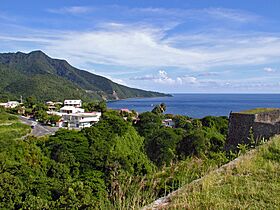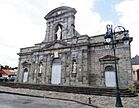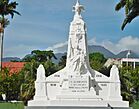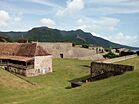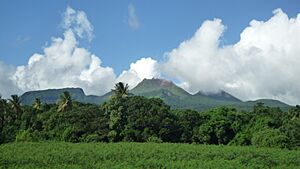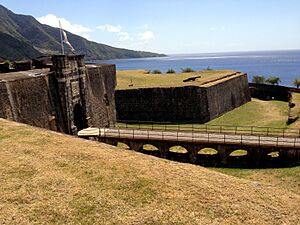Basse-Terre facts for kids
Quick facts for kids
Basse-Terre
|
||
|---|---|---|
|
Prefecture and commune
|
||
|
Top: View from Fort Louis Delgrès in Basse-Terre; Middle: Cathedral of Our Lady of Guadaleoupe, Monument to the dead of Basse-Terre; Bottom: Fort Delgrès, Basse-Terre Town Hall
|
||
|
||
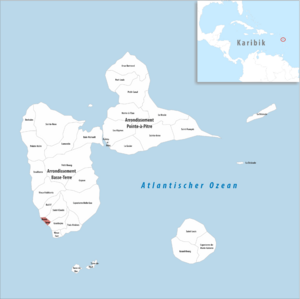
Location of the commune (in red) within Guadeloupe
|
||
| Country | France | |
| Overseas region and department | Guadeloupe | |
| Arrondissement | Basse-Terre | |
| Canton | Basse-Terre | |
| Intercommunality | CA Grand Sud Caraïbe | |
| Area
1
|
5.78 km2 (2.23 sq mi) | |
| Population
(2021)
|
9,779 | |
| • Density | 1,691.9/km2 (4,382/sq mi) | |
| Time zone | UTC−04:00 (AST) | |
| INSEE/Postal code |
97105 /97100
|
|
| 1 French Land Register data, which excludes lakes, ponds, glaciers > 1 km2 (0.386 sq mi or 247 acres) and river estuaries. | ||
Basse-Terre is a city in Guadeloupe, a French overseas department in the Lesser Antilles. It is the capital city of Guadeloupe. The city is located on Basse-Terre Island, which is the western part of Guadeloupe.
Even though it's the capital, Basse-Terre is the second-largest city in Guadeloupe. The biggest city is Pointe-à-Pitre. In 2012, Basse-Terre and its nearby areas had about 44,864 people. About 11,534 of them lived in the city itself.
Contents
Geography of Basse-Terre
Basse-Terre is in the southwest part of Basse-Terre Island. This island is about 100 kilometers north of Dominica. It is also about 450 kilometers southeast of Puerto Rico.
The city sits at the bottom of the Soufrière volcano. Three main roads connect Basse-Terre to the rest of the island.
- The N1 road goes south along the coast. It then turns inland to Gourbeyre. It continues all the way around the coast to Pointe-à-Pitre.
- The N2 road goes north along the coast to Vieux Habitants. It also goes all the way around the coast. It joins the N1 road at Baie Mahault.
- The N3 road crosses the city and goes inland to Saint-Claude.
Basse-Terre has a port where cruise ships arrive. There is also a ferry service to the Îles des Saintes.
The city is mostly urban, meaning it has many buildings and people. There is some farmland in the northeast and northwest.
The different neighborhoods in Basse-Terre include Agincourt, Carmel, Petit-Paris, and Versailles.
 |
Baillif | Saint-Claude |  |
|
| Caribbean Sea | ||||
| Caribbean Sea | St Charles | Gourbeyre |
Climate in Basse-Terre
Basse-Terre has a climate that is between a tropical rainforest climate and a tropical monsoon climate. This means it has warm temperatures all year round.
| Climate data for Basse-Terre | |||||||||||||
|---|---|---|---|---|---|---|---|---|---|---|---|---|---|
| Month | Jan | Feb | Mar | Apr | May | Jun | Jul | Aug | Sep | Oct | Nov | Dec | Year |
| Record high °C (°F) | 31 (88) |
32 (90) |
31 (88) |
32 (90) |
33 (91) |
33 (91) |
37 (99) |
38 (100) |
33 (91) |
33 (91) |
32 (90) |
32 (90) |
38 (100) |
| Mean daily maximum °C (°F) | 28 (82) |
28 (82) |
28 (82) |
29 (84) |
30 (86) |
31 (88) |
31 (88) |
31 (88) |
31 (88) |
30 (86) |
29 (84) |
28 (82) |
30 (86) |
| Daily mean °C (°F) | 24 (75) |
24 (75) |
25 (77) |
26 (79) |
27 (81) |
27 (81) |
27 (81) |
27 (81) |
27 (81) |
27 (81) |
26 (79) |
25 (77) |
26 (79) |
| Mean daily minimum °C (°F) | 20 (68) |
20 (68) |
21 (70) |
22 (72) |
23 (73) |
24 (75) |
24 (75) |
23 (73) |
23 (73) |
23 (73) |
22 (72) |
21 (70) |
22 (72) |
| Record low °C (°F) | 15 (59) |
16 (61) |
15 (59) |
16 (61) |
17 (63) |
20 (68) |
20 (68) |
20 (68) |
18 (64) |
20 (68) |
17 (63) |
15 (59) |
15 (59) |
| Average precipitation mm (inches) | 80 (3.1) |
60 (2.4) |
70 (2.8) |
110 (4.3) |
150 (5.9) |
120 (4.7) |
160 (6.3) |
190 (7.5) |
230 (9.1) |
220 (8.7) |
220 (8.7) |
140 (5.5) |
1,750 (69) |
| Source: Weatherbase | |||||||||||||
History of Basse-Terre
Early Native American Village
Before the French arrived, Basse-Terre was a village. It was home to Native American farmers and potters. Archaeologists found old tools and human remains near the Basse-Terre Cathedral. This shows that people lived here a long time ago.
In 2005, more discoveries were made. They found food scraps, stone tools, and a tomb. This tells us more about the early people who lived here.
Founding of Basse-Terre (1635–1649)
In 1635, French explorers came to Guadeloupe. They were looking for a place to settle. The first group landed far from Basse-Terre. They faced hunger and moved south.
Relationships with the Native Americans became difficult. A fort was built for protection. In 1649, Charles Houël du Petit Pré built a new fort. This fort was on the right bank of the Galion River.
Soon after, a church was built. The city of Basse-Terre grew around this church and the fort. This was the true beginning of Basse-Terre.
Growth of Saint-François (around 1680)
Around 1680, another settlement grew nearby. It was on the other side of the River of Herbs. A chapel was built there, dedicated to Saint Francis of Assisi. This is where the current Guadeloupe Cathedral stands.
People moved to this new area, Saint Francis. This was because English privateers often attacked and burned Basse-Terre. They thought the fort attracted these attackers. A stone bridge was built in 1739 to connect the two areas.
British Occupation (1759–1763)
On January 23, 1759, British forces captured Guadeloupe. The British occupied the island until 1763. It was then returned to France in the Treaty of Paris. Basse-Terre started to recover after this.
Revolutionary Times (1789–1802)
The French Revolution reached Basse-Terre in 1789. In 1794, the British captured Guadeloupe again. But a French leader named Victor Hugues quickly recaptured the island. He also helped end slavery.
In 1802, Napoleon sent General Antoine Richepanse to bring back slavery. There was a fight against Louis Delgrès, a Guadeloupe hero. Delgrès retreated to the fort and later left it.
Challenges and Recovery (1802–1870)
For over 20 years, Basse-Terre faced many problems. It was occupied by other forces several times. Four hurricanes also hit the city between 1816 and 1844.
Despite these challenges, the city began to rebuild. New buildings like a military hospital and a bishopric were constructed. New neighborhoods like Versailles and Petit-Paris were also created. However, a cholera epidemic in 1865 caused more difficulties.
Modern Development (1870–1976)
From 1870, Basse-Terre started to truly recover. Its town hall was opened in 1899. In 1913, it became the first city in Guadeloupe to have electricity.
After a big storm in 1928, architect Ali Tur helped rebuild. He designed the courthouse, the General Council building, and a market. A modern port was built between 1961 and 1964. A new road, the boulevard, was also built along the coast.
Since 1976: Volcano and Population Changes
In 1976, many people had to leave Guadeloupe. This was because the Soufrière volcano became very active. About 73,600 people were evacuated. Some of them never returned to Basse-Terre. They moved to other areas like Jarry.
For 20 years, the city center lost many residents. People moved to nearby towns like Baillif, Saint-Claude, and Gourbeyre. The city has tried to bring people back.
Symbols of Basse-Terre
| The fleur-de-lis symbols show that the city belongs to France. The sun symbol shows that it is a tropical island.
Blazon: |
The coat of arms of Basse-Terre has a red background with a golden sun. At the top, there are three golden fleur-de-lis symbols on a blue background.
City Government
Basse-Terre is led by a mayor. The mayor is in charge of the city's daily operations.
List of Mayors
| From | To | Name |
|---|---|---|
| 1790 | 1792 | Jean Baptiste Louis Thirus de Pautrizel |
| 1792 | La Graët | |
| 1821 | 1829 | Baudet |
| 1831 | 1837 | DuperronN |
| 1837 | 1843 | Jean Rémi Terrail |
| 1843 | 1846 | Charles Le Dentu |
| 1847 | 1848 | Aristide Lignières |
| 1848 | 1848 | J. L. Rousseau |
| 1848 | 1848 | Lomont Bernard |
| 1848 | 1850 | P. H. Laurichesse |
| 1850 | 1850 | Pothonier |
| 1850 | 1852 | P. H. Laurichesse |
| 1853 | 1854 | Puech |
| 1854 | 1863 | Rullier |
| 1863 | 1869 | A. Eggimann |
| 1869 | 1871 | Aristide Lignères |
| 1871 | 1876 | Emile Le Dentu |
| 1876 | 1883 | Richard Jean-Romain |
| 1883 | 1884 | Hildebert Bernus |
| 1884 | 1888 | Auguste Silvie |
| 1888 | 1893 | Hildebert Bernus |
| 1893 | 1894 | J. Cascon |
| 1897 | 1902 | Wilfrid Montout |
| 1897 | 1900 | Delmance Demonchy |
| 1911 | 1925 | Arnaud Lignières |
| 1925 | 1933 | Georges Favreau |
| 1933 | 1938 | Maurice Marie-Claire |
| 1938 | 1944 | Maurice Martin |
- Mayors from 1945
| From | To | Name | Party | Position |
|---|---|---|---|---|
| 1945 | 1951 | Joseph Pitat | Doctor, President of the General Council 1945–1949 | |
| 1951 | 1953 | Annibal Waneybergue | Retired | |
| 1953 | 1959 | Élie Chauffrein | PCF | |
| 1959 | 1971 | Gaston Feuillard | Lawyer, MP 1958–1973 | |
| 1971 | 1995 | Jérôme Cléry | PCG | Doctor |
| 1995 | 2001 | Lucette Michaux-Chevry | RPR | Lawyer, President of the Regional Council 1992–2004, Senator 1995–2011 |
| 2001 | 2001 | Pierre Martin | DVD | |
| 2001 | 2008 | Guy Georges | DVD | Merchant |
| 2008 | 2014 | Lucette Michaux-Chevry | UMP | Lawyer, former Minister, Senator |
| 2014 | 2020 | Marie-Luce Penchard | UMP | Territorial Administrator, former Minister |
| 2020 | 2026 | André Atallah |
Courts and Offices
Basse-Terre has a Courthouse built in 1934. It holds several important courts. These include the Court of Appeal and a High Court. The city also has a police station and a prison.
Sister City
Basse-Terre has a special friendship with one city:
 Pondicherry (India) since 1981. This is called a "twinning" association.
Pondicherry (India) since 1981. This is called a "twinning" association.
Population of Basse-Terre
In 2017, Basse-Terre had 10,058 people living there. The number of people in the city has been going down since 2007.
| Historical population | ||
|---|---|---|
| Year | Pop. | ±% p.a. |
| 1954 | 11,837 | — |
| 1961 | 13,978 | +2.40% |
| 1967 | 15,690 | +1.94% |
| 1974 | 15,457 | −0.21% |
| 1982 | 13,656 | −1.54% |
| 1990 | 14,003 | +0.31% |
| 1999 | 12,410 | −1.33% |
| 2007 | 12,451 | +0.04% |
| 2012 | 11,534 | −1.52% |
| 2017 | 10,058 | −2.70% |
| Source: INSEE | ||
Schools in Basse-Terre
The city has 24 schools for different age groups:
- 5 public kindergartens: Chevalier St-Georges, Circonvallation, Laure Abel, Petit Paris, and Rivière des Pérès.
- 5 public primary schools: Elie Chaufrein, Gaston Michineau, Mélanie Milly, Regina Richard, and Rivière des Pérès.
- 3 public junior high schools: Joseph Pitat, Les Persévérants, and Pensionnat de Versailles.
- 2 public senior high schools:
- Lycée et lycée professionnel les Persévérants
- Lycée polyvalent Raoul Georges Nicolo
There are also private schools:
- 3 private primary schools: Immaculée Versailles, Jeanne-D Arc, and Saint Paul de Bouillon.
- Private secondary schools: Collège Les Persévérants, LGT/LP/LT Versailles.
City Layout
Basse-Terre grew along a main street called Grand Rue. The River of Herbs divides the city into older parts. The city is built on a narrow strip of land. This land is between the Caribbean Sea and the mountains. The Soufrière volcano is to the northeast.
The city stretches for about 3 kilometers. It has hills and valleys called ravines.
City Borders
The boundaries of Basse-Terre have changed over time. In 1837, two new towns were created from Basse-Terre's outer areas. These were Saint-Claude and Gourbeyre. Over the years, Basse-Terre has grown to include more neighborhoods.
Homes in Basse-Terre
In 2017, there were 6,143 homes in Basse-Terre. Most of these (77%) are people's main homes. About 22.2% of homes were empty.
Economy of Basse-Terre
Basse-Terre is working to improve its economy. It is focusing on making its port better for cruise ships. A new ferry terminal was opened in 2015. This terminal can hold 100 people and has places to buy tickets and food.
Jobs in Basse-Terre
In 2017, the unemployment rate in Basse-Terre was 40.7%. This means many people who wanted jobs did not have them. The total number of people working was 4,286.
| Agricultural workers | Shopkeepers, business owners | Managers and Professionals | Middle managers | Employees | Workers | |
|---|---|---|---|---|---|---|
| Basse-Terre | 0.9% | 6.2% | 3.7% | 16.1% | 39.9% | 20.0% |
| Source of data: INSEE | ||||||
Culture and Important Places
Basse-Terre has many buildings and places that are important to its history.
Historic Buildings
- Fort Delgrès
 : This fort was built in 1649. It has been expanded and changed many times. It was captured and recaptured during wars. It has had several names, including Fort Saint-Charles and Fort Richepanse. Today, it is called Fort Delgrès. It became a historical monument in 1977.
: This fort was built in 1649. It has been expanded and changed many times. It was captured and recaptured during wars. It has had several names, including Fort Saint-Charles and Fort Richepanse. Today, it is called Fort Delgrès. It became a historical monument in 1977. - Gerty Archimede Museum: This museum opened in 1984. It is in the house where the famous lawyer and politician Gerty Archimede lived.
- Town Hall: The city's town hall was built in 1889. It has seven paintings by Georges Rohner inside. These paintings show scenes from Basse-Terre and its history.
- Courthouse
 : The courthouse was built by Ali Tur in 1934. It holds all the main courts for the area. It is also a historical monument.
: The courthouse was built by Ali Tur in 1934. It holds all the main courts for the area. It is also a historical monument. - Market Clock: This clock is inside the City Spice Market. It was also designed by Ali Tur in 1932.
- Gerville-Réache High School
 : This building was first a military hospital in the early 1800s. In the 1950s, it became a school. It is a historical monument.
: This building was first a military hospital in the early 1800s. In the 1950s, it became a school. It is a historical monument. - General Council of Guadeloupe
 : This building is also a historical monument.
: This building is also a historical monument. - Prefecture of Guadeloupe
 : This building was once a military area. The current building was built by Ali Tur between 1932 and 1935. It became the main government office in 1951. It is a historical monument.
: This building was once a military area. The current building was built by Ali Tur between 1932 and 1935. It became the main government office in 1951. It is a historical monument.
Religious Sites
- Cathedral of Our Lady of Guadeloupe
 : This cathedral was built over an older wooden chapel. It was first called Saint Francis Church. In 1877, it was named Our Lady of Guadeloupe. It became a historical monument in 1975.
: This cathedral was built over an older wooden chapel. It was first called Saint Francis Church. In 1877, it was named Our Lady of Guadeloupe. It became a historical monument in 1975. - Cathedral Bell Tower
 : The bell tower of the cathedral was built in 1837. It stands separately behind the main church. It is also a historical monument.
: The bell tower of the cathedral was built in 1837. It stands separately behind the main church. It is also a historical monument. - Church of Our Lady of Mount Carmel
 : This church was built by the first settlers in the 1600s. It was important for the founding of Basse-Terre. It became a historical monument in 2006. The church has old items like a cabinet and a processional cross.
: This church was built by the first settlers in the 1600s. It was important for the founding of Basse-Terre. It became a historical monument in 2006. The church has old items like a cabinet and a processional cross. - Saint Antoine Monastery
 : This monastery was started in 1897 as a place for charity. It became a historical monument in 2007.
: This monastery was started in 1897 as a place for charity. It became a historical monument in 2007.
Festivals and Events
- The 'Festival Patronale' is celebrated on December 12.
- The Festival of Carmel is on July 16.
Sports in Basse-Terre
Basse-Terre has several sports facilities:
- Sports Palace of Rivière-des-Pères (1600 seats)
- Stadium of Rivière-des-Peres (4000 seats)
- Inter-communal Swimming Pool at Rivière-des-Peres
- Félix-Éboué Stadium
- Multisports halls
These facilities are used by local sports clubs, including:
- The Cygne Noir (football)
- La Gauloise (football)
- The Racing Club of Basse-Terre (football)
- The Étoile du Carmel (football)
- The Basse-Terre Rugby Club (rugby)
Media
The TV channel Guadeloupe I and radio Guadeloupe I are available in Basse-Terre.
Notable People from Basse-Terre
Many important people have connections to Basse-Terre:
- Charles Houël du Petit Pré: He founded Basse-Terre in 1649.
- Jacques-Nicolas Gobert: Born in Basse-Terre in 1760, he became a Major-General in the French Revolution.
- Jean-Jacques Ambert: A General in the French armies, he died in Basse-Terre.
- Louis Delgrès: A hero of Guadeloupe, he was a Commandant of Basse-Terre in 1802.
- Antoine Richepanse: A French General sent by Napoleon, he died in Basse-Terre in 1802.
- Ferdinand Joseph L'Herminier: Born in Basse-Terre in 1802, he was a botanist and zoologist.
- Louisy Mathieu: Born in Basse-Terre in 1817, he was a former slave who became a Member of Parliament.
- Léon Hennique: Born in Basse-Terre in 1850, he was a naturalist novelist.
- Camille Mortenol: A ship's captain born in 1859, known for his math skills.
- Élie Bloncourt: Born in Basse-Terre in 1896, he was a Member of Parliament and a Resistance fighter in World War II.
- Gerty Archimede: Born in 1909, she was the first woman lawyer in Guadeloupe.
- Paul Niger: A writer and administrator, born in Basse-Terre in 1915.
- Joseph Aucourt: A footballer born in Basse-Terre in 1927.
- Guy Hatchi: A former French footballer born in Basse-Terre in 1934.
- Jacques Rousseau: A French athlete born in Basse-Terre in 1951, European champion in long jump.
- Willy Salzedo: A pianist and composer born in Basse-Terre in 1961.
- Luc Sonor: A French international footballer born in Basse-Terre in 1962.
- Evelyne Elien: A French athlete born in Basse-Terre in 1963, specializing in 400 meters.
- Tanya Saint-Val: A singer born in Basse-Terre in 1965.
- Élie Domota: A union leader born in Basse-Terre in 1967.
- Marie-José Pérec: Born in Basse-Terre in 1968, she is a triple Olympic champion in track and field.
- Jean-Pierre Cyprien: A footballer born in Basse-Terre in 1969.
- Jane Fostin: A singer born in Basse-Terre in 1973.
- Rony Martias: A racing cyclist born in Basse-Terre in 1980.
- Sonia Petro: Deputy Mayor since 2020.
- Indira Ampiot: Born in 2004, she was crowned Miss France 2023.
- Minia Biabiany: An artist born in Basse-Terre in 1988.
Images for kids
See also
 In Spanish: Basse-Terre para niños
In Spanish: Basse-Terre para niños


